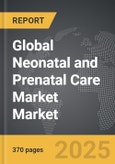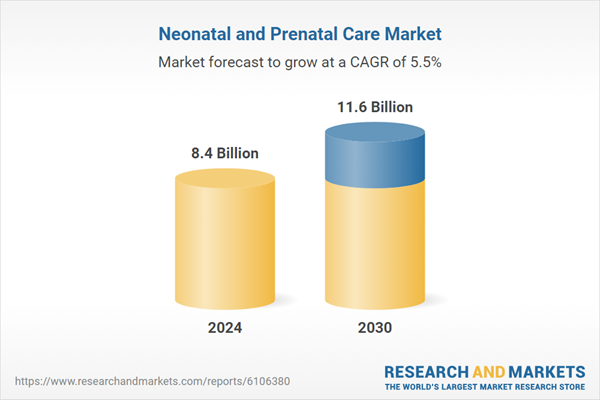Global Neonatal and Prenatal Care Market - Key Trends & Drivers Summarized
Why Is Neonatal and Prenatal Care Central to Maternal and Infant Health?
Neonatal and prenatal care encompasses medical services, monitoring, and support provided before and after childbirth to ensure the health of both mother and newborn. Prenatal care focuses on early diagnosis, maternal nutrition, fetal development monitoring, and risk management throughout pregnancy. Neonatal care addresses the immediate medical needs of newborns, especially preterm or low birthweight infants, through intensive monitoring, temperature regulation, infection prevention, and respiratory support.Timely prenatal care is essential for detecting complications such as gestational diabetes, preeclampsia, and fetal anomalies. Interventions during pregnancy can improve birth outcomes and reduce risks of stillbirth, birth injury, or developmental delays. In neonatal settings, early interventions in the first 28 days of life are critical for reducing infant mortality and preventing long-term complications. Growth in maternal health awareness and access to specialized neonatal intensive care units (NICUs) is improving outcomes across high-risk pregnancies and births.
How Are Medical Technologies Transforming Neonatal and Prenatal Care Delivery?
Advances in diagnostic imaging, fetal monitoring, and neonatal equipment have significantly strengthened prenatal and neonatal care practices. Ultrasound systems now offer high-resolution, real-time 3D and 4D imaging, enabling early detection of structural abnormalities. Doppler and non-stress testing allow real-time assessment of fetal well-being. Genetic screening technologies, including non-invasive prenatal testing (NIPT), are improving early identification of chromosomal anomalies without risk to the fetus.In neonatal care, the availability of sophisticated incubators, phototherapy units, continuous positive airway pressure (CPAP) systems, and advanced ventilators enhances survival rates among premature infants. Portable monitoring devices, infusion pumps, and temperature control systems ensure uninterrupted critical care in NICUs. Telemedicine platforms and remote fetal monitoring are also enabling prenatal surveillance in rural and underserved areas, bridging access gaps and supporting community-level interventions.
Which Health Systems and Demographic Trends Are Shaping Market Demand?
Demand is influenced by rising birth rates in low- and middle-income countries and increasing maternal age in high-income regions. Urbanization, delayed pregnancies, and lifestyle-related health issues have led to a rise in high-risk pregnancies requiring advanced prenatal and neonatal interventions. Healthcare systems are investing in capacity-building, workforce training, and infrastructure expansion to manage these risks more effectively.Government programs and international health initiatives focused on reducing maternal and infant mortality are supporting broader access to prenatal screenings and neonatal support services. Private healthcare providers are expanding maternal care offerings, particularly in urban centers, with integrated maternity packages. Growing insurance coverage for pregnancy-related services and neonatal care is also encouraging early registration and institutional deliveries, contributing to improved outcomes and higher demand for care services.
Growth in the Neonatal and Prenatal Care Market Is Driven by Several Factors…
Growth in the neonatal and prenatal care market is driven by several factors. Rising incidence of preterm births and maternal complications supports demand for advanced neonatal interventions and monitoring. Improved imaging and diagnostic technologies facilitate early detection of fetal conditions, enabling timely care planning. Expansion of NICUs and maternal health programs increases access to essential services. Public and private investment in women's health, along with awareness campaigns, encourages routine prenatal checkups and institutional childbirth. Innovations in wearable monitoring, portable diagnostic tools, and telehealth platforms extend reach to remote populations. These developments together are strengthening both preventive and critical care aspects of maternal and infant health globally.Report Scope
The report analyzes the Neonatal and Prenatal Care market, presented in terms of market value (US$). The analysis covers the key segments and geographic regions outlined below:- Segments: Equipment (Prenatal Equipment, Neonatal Equipment); Application (ENT Application, Cardiovascular Application, Respiratory Application, Other Applications); End-Use (Hospitals End-Use, Pediatric & Neonatal Clinics End-Use, Nursing Homes End-Use).
- Geographic Regions/Countries: World; United States; Canada; Japan; China; Europe (France; Germany; Italy; United Kingdom; Spain; Russia; and Rest of Europe); Asia-Pacific (Australia; India; South Korea; and Rest of Asia-Pacific); Latin America (Argentina; Brazil; Mexico; and Rest of Latin America); Middle East (Iran; Israel; Saudi Arabia; United Arab Emirates; and Rest of Middle East); and Africa.
Key Insights:
- Market Growth: Understand the significant growth trajectory of the Prenatal Equipment segment, which is expected to reach US$8.1 Billion by 2030 with a CAGR of a 6.4%. The Neonatal Equipment segment is also set to grow at 3.6% CAGR over the analysis period.
- Regional Analysis: Gain insights into the U.S. market, valued at $2.3 Billion in 2024, and China, forecasted to grow at an impressive 8.9% CAGR to reach $2.4 Billion by 2030. Discover growth trends in other key regions, including Japan, Canada, Germany, and the Asia-Pacific.
Why You Should Buy This Report:
- Detailed Market Analysis: Access a thorough analysis of the Global Neonatal and Prenatal Care Market, covering all major geographic regions and market segments.
- Competitive Insights: Get an overview of the competitive landscape, including the market presence of major players across different geographies.
- Future Trends and Drivers: Understand the key trends and drivers shaping the future of the Global Neonatal and Prenatal Care Market.
- Actionable Insights: Benefit from actionable insights that can help you identify new revenue opportunities and make strategic business decisions.
Key Questions Answered:
- How is the Global Neonatal and Prenatal Care Market expected to evolve by 2030?
- What are the main drivers and restraints affecting the market?
- Which market segments will grow the most over the forecast period?
- How will market shares for different regions and segments change by 2030?
- Who are the leading players in the market, and what are their prospects?
Report Features:
- Comprehensive Market Data: Independent analysis of annual sales and market forecasts in US$ Million from 2024 to 2030.
- In-Depth Regional Analysis: Detailed insights into key markets, including the U.S., China, Japan, Canada, Europe, Asia-Pacific, Latin America, Middle East, and Africa.
- Company Profiles: Coverage of players such as braham Blacksmith / Black Smith Surgical, Amkay Products Pvt. Ltd., Ambler Surgical Corp, Arsenal Surgical (Black Smith), Becton Dickinson (BD) and more.
- Complimentary Updates: Receive free report updates for one year to keep you informed of the latest market developments.
Some of the 37 companies featured in this Neonatal and Prenatal Care market report include:
- Atom Medical Corporation
- Becton, Dickinson and Company (BD)
- Bionet Co., Ltd.
- Cardinal Health, Inc.
- Drägerwerk AG & Co. KGaA
- Fisher & Paykel Healthcare
- Fujifilm Holdings Corporation
- GE HealthCare
- Ibis Medical Equipment & Systems
- Koninklijke Philips N.V.
- Masimo Corporation
- Medela AG
- Medtronic plc
- Natus Medical Incorporated
- Neotech Products, LLC
- Nihon Kohden Corporation
- Novos Medical Systems
- Siemens Healthineers AG
- Utah Medical Products, Inc.
- Vyaire Medical, Inc.
This edition integrates the latest global trade and economic shifts into comprehensive market analysis. Key updates include:
- Tariff and Trade Impact: Insights into global tariff negotiations across 180+ countries, with analysis of supply chain turbulence, sourcing disruptions, and geographic realignment. Special focus on 2025 as a pivotal year for trade tensions, including updated perspectives on the Trump-era tariffs.
- Adjusted Forecasts and Analytics: Revised global and regional market forecasts through 2030, incorporating tariff effects, economic uncertainty, and structural changes in globalization. Includes historical analysis from 2015 to 2023.
- Strategic Market Dynamics: Evaluation of revised market prospects, regional outlooks, and key economic indicators such as population and urbanization trends.
- Innovation & Technology Trends: Latest developments in product and process innovation, emerging technologies, and key industry drivers shaping the competitive landscape.
- Competitive Intelligence: Updated global market share estimates for 2025, competitive positioning of major players (Strong/Active/Niche/Trivial), and refined focus on leading global brands and core players.
- Expert Insight & Commentary: Strategic analysis from economists, trade experts, and domain specialists to contextualize market shifts and identify emerging opportunities.
Table of Contents
Companies Mentioned (Partial List)
A selection of companies mentioned in this report includes, but is not limited to:
- Atom Medical Corporation
- Becton, Dickinson and Company (BD)
- Bionet Co., Ltd.
- Cardinal Health, Inc.
- Drägerwerk AG & Co. KGaA
- Fisher & Paykel Healthcare
- Fujifilm Holdings Corporation
- GE HealthCare
- Ibis Medical Equipment & Systems
- Koninklijke Philips N.V.
- Masimo Corporation
- Medela AG
- Medtronic plc
- Natus Medical Incorporated
- Neotech Products, LLC
- Nihon Kohden Corporation
- Novos Medical Systems
- Siemens Healthineers AG
- Utah Medical Products, Inc.
- Vyaire Medical, Inc.
Table Information
| Report Attribute | Details |
|---|---|
| No. of Pages | 370 |
| Published | November 2025 |
| Forecast Period | 2024 - 2030 |
| Estimated Market Value ( USD | $ 8.4 Billion |
| Forecasted Market Value ( USD | $ 11.6 Billion |
| Compound Annual Growth Rate | 5.5% |
| Regions Covered | Global |









